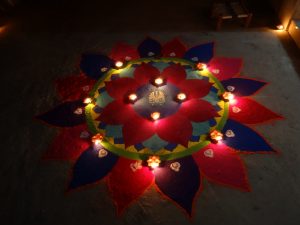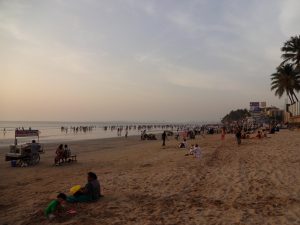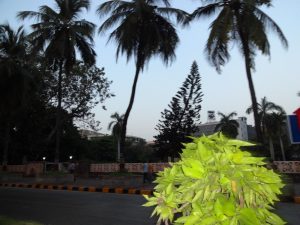
When I reached Mumbai on November 16th, though, the mood was different. Instead of the usual post-holiday loosened waistlines and work ethics, the city was on edge.
I was out with my aunt when I asked her what was going on. (Paraphrased, obviously.)
“There’s a rumor that Bal Thackeray is dead.”
“Who?”
“He’s a very powerful political leader. He runs — ran — the Shiv Sena. The rumor is that he died a few days ago, but they didn’t want to disrupt Diwali so they kept it quiet.”
I looked around (and, unfortunately, didn’t take a single picture). There were plenty of stands and road dividers papered with political posters. I’m not the fastest reader in Hindi, but two words kept showing up, on the ubiquitous bright yellow- or orange-painted concrete:

Shiv, as in Shiva, a Hindu god associated with both creation and destruction. Honestly, out of all the major Hindu gods, I think his mythos has the most murder in it. And then ‘sena’ — it means ‘army.’ There is nothing ambiguous about this.
I’d like to take a moment to note my perception of political advertising in India. There isn’t a ton of it in America, beyond yard signs, but in India, you get pictures covered with names/writing (seriously, I’m not fast at reading Hindi…), oftentimes with the politician depicted wearing a garland and with a mark on his forehead, as if he’s just completed a puja.
With Thackeray, there was an additional dimension of veneration I wasn’t familiar with. I heard — can’t remember if I also saw — that people put incense in front of his portraits, much as you’d do for gods and dead relatives.
The leader of the ‘Army of Shiva’ might be dead. Watch your back.
I needed ‘ethnic wear’ (yes, that’s how the section for Indian clothes is labeled in India) so we went to the mall. My aunt kept her phone handy, for the newsfeed.
As I browsed racks of garish salwars, she told me more about the situation. “The family does whatever they want. There’s stories about his wife going into jewelry stores with her bodyguards, picking out what she wants, and walking out.”

In India, it’s not uncommon to hear of political enemies being beaten — hell, corporal punishment is acceptable in schools. There’s a pile of Bollywood movies featuring vigilante police officers who defy corrupt superiors and political party thugs to bring justice to the people.
“Aren’t people bothered by this? They’re practically terrorizing people.”
As the world’s largest direct democracy, India has a slew of political parties. Shiv Sena was not the only option on the table, and back in 2012, the BJP’s ‘saffronization’ (read: Hindu-nationalistic, which dovetails with the Shiv Sena) had not advanced as far as when I went there again in 2015.
“They can’t do anything about it, if they don’t want to be beaten.”
I asked my aunt if Thackeray had done any good for the citizens of Mumbai — not just his followers.
She thought about my question. “He made the streets safe for women. Now, a woman can walk home by herself at night, without worrying about harassment.”
When Mumbai added special train compartments for women/children, men were still pinching women through the bars.
We had paid up and had left the store. Souvenirs I’d bought for myself and friends tinkled in my bag. I could’ve gotten them for a tenth of the price in Rajasthan, but the ones in Mumbai were more neatly packaged, with the same tags you’d find in New Age-y stores in the US.
“Let’s go,” she said. We had originally planned to look around a bit more but the news was breaking.
It was official: Bal Thackeray was dead.
We left the mall in a hurry, looking for a rickshaw. On the sidewalk opposite us, we saw a group of forty young men, dressed in the casual clothes of the lower middle class — thin button-up collar shirts and loose pants, clean hair, tan sandals with flapping buckles. They were grouped near a Cafe Coffee Day — an inoffensive cafe chain found throughout India, with the same ‘cafe frappe’ I’d had in Greece.

“They’re making sure it’s closed,” my aunt told me.
“What?”
“Respect.” She made a face. “For Bal Thackeray. Show respect by closing your store, go home, pray….” We walked past the entrance to a Tata campus. “If we need to, we can go inside this factory. I’m friends with the owner.”
This was not a group. It was a gang, ready to break windows and beat anyone who refused to mourn their leader.
We lost sight of the group, and then we got a rickshaw. We reached her home without incident, which was good because I had a flight back to my home that night. I was ready to retreat to the sanity of American politics, with loyalty to country and values rather than individuals and rhetoric. Despite Romney’s ‘47%’ scandal, the mainstream discourse was pretty sane.
My relatives live near the airport, but the traffic means you’ve got to leave 2–3 hours early. On this day, it took thirty minutes. All of Mumbai was in mourning, enforced by fiat.
I’m paranoid about travel and had insisted on leaving at least a little early, so I hung out in the airport and drank mango lassi until my flight.
A month after I returned to the US, the horrific gang rape and murder of a woman in Delhi made world headlines.
This post originally appeared on Medium and has been reprinted with permission.

